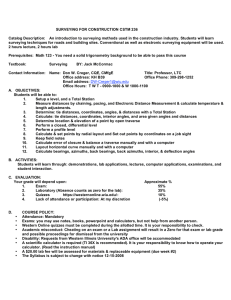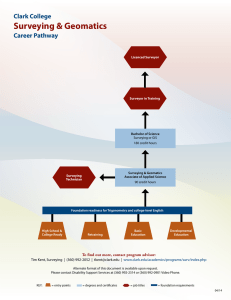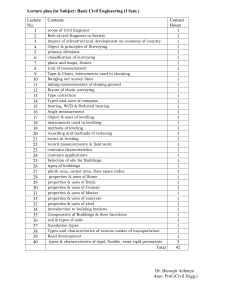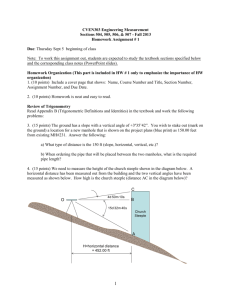Geomatics for Civil & Environmental Engineers: Intro to Surveying
advertisement
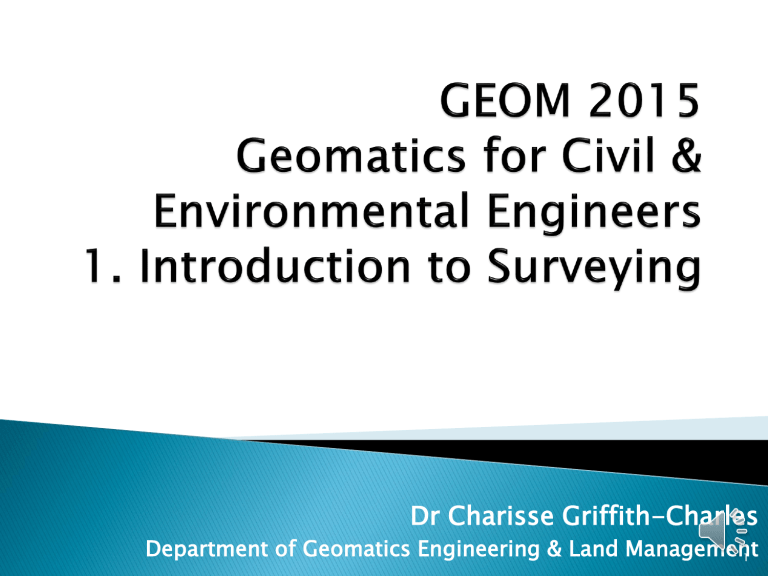
Dr Charisse Griffith-Charles Department of Geomatics Engineering & Land Management 1 Credits : 2 credit hours Lectures: Schedule: 2 hrs per week Mondays 10:00am to 12:00pm Labs : Schedule: 3 hrs per week Fridays 1:00 to 4:00 pm 2 To give students an appreciation of Engineering Surveying principles and techniques with respect to the following: ◦ ◦ ◦ ◦ ◦ ◦ ◦ ◦ ◦ Coordinate Geometry Distances Angles Levels Control Surveys Errors Maps/Plans Curves Cut and Fill/Earthworks 3 Laboratory exercises In-Course exam Quizzes Final Examination : : : : 30% 5% 5% 60% Plagiarism will not be tolerated Assignments must be submitted completed and submitted on time Students must adhere to H&S at all times For Labs should have appropriate footwear (no slipper, sandals, open-toed...) 4 The Student should be able to: Explain the fundamental concepts of survey techniques, measurement, instrumentation, and errors. Explain the principles of angular, height, and distance measurement, along with the related instruments and associated calibration procedures. Apply calculations for corrections to survey observations with an analysis of survey quality. Apply survey techniques and computations to perform basic 2-D and 3-D topographic mapping exercises. Evaluate the different types of coordinate systems and procedures to be able to determine an appropriate methodology to perform coordinate, areas and volumes computations with basic adjustments. 5 Week 1 - Sept. 04th : Introduction to Surveying Week 2 – Sept. 11th : Errors, Uncertainty and Distances Week 3 – Sept. 18th : Levelling and Vertical Control, Angle Measurements Week 4 – Sept. 25th : Republic Day Week 5 – Oct. 02nd : Control Surveys and Computations Week 6 – Oct. 09th : Mid Term Exam Week 7 – Oct. 16th : Detail Surveys and Mapping Week 8 – Oct. 23rd : Curves and Setting-out Week 9 - Oct. 30th : Earth Works and Cross Sections Week 10 – Nov. 06th : Earth Works and Cross Sections Week 11 – Nov. 13th : Projections and Datums Week 12 – Nov. 20th : Global Positioning Systems 6 Readings: 1. Schofield, W., and Mark Breach. 2007. Engineering surveying. Oxford; Burlington, MA: Butterworth-Heinemann. 2. Sterling, M. 2005. Trigonometry Workbook for Dummies. Wiley Publications Inc. 3. Shepherd, F. A. 1968. Surveying problems and solutions. London: Edward Arnold. 4. Kavanagh, B. F. 2014. Surveying with Construction Applications. Pearson 7 ◦ The Science of determining the three dimensional position of natural and manmade features, on or beneath the surface of the earth. (Schofield and Breach 2007) ◦ Geomatics - the branch of science that deals with the collection, analysis, and interpretation of data relating to the earth's surface. – (Oxford dictionary) 8 9 May be: Geodetic Surveying, Topographic Surveying, Photogrammetry, Hydrographic Surveying, Cadastral Surveying, Engineering Surveying 10 Surveying is important to projects for: ◦ Planning ◦ Design ◦ Construction 11 Must have an understanding of the: Data Required Limitations of Measurement Tasks Limitations of Instruments Limitations of Techniques Limitation of Time Health and Safety Economics of surveys 12 1. Control ◦ Framework of well defined coordinated (X, Y and/or Z) stations. ◦ Coordinates have been obtained using precise and rigorous methods to achieve defined levels of accuracy ◦ Coordinates include information about the precision and reliability of the values ◦ Coordinate determination uses operations that ‘work from the whole to the part’ 13 2. Economy of Accuracy ◦ You cannot set-out 5mm steel works using 2cm control, but you also cannot always use the best equipment and/or take too many excess readings ◦ "Not everything that counts can be counted, and not everything that can be counted counts." - Albert Einstein ◦ Define Job Standards ◦ Use the optimal instrumentation ◦ Use the optimal techniques and methods 14 3. Consistency ◦ A chain is only as strong as its weakest link similarly Information is only as good as the weakest data used to interpret it ◦ Survey data must be derived using consistent instrumentation and methodologies ◦ Otherwise accuracies must be clearly stated 15 4. Independent Checks ◦ Every human activity should be duplicated if it is not self checking. Systems must be used to check that no errors exist. Where errors exist, there must be ways of finding them. ◦ Applied at all stages of a survey ◦ Guards against blunders and gross errors 16 5. Safeguard ◦ Data without notes are just numbers. Data is not information, and interpreting wrongly can help you make some bad decisions. ◦ Ensure records are written in permanent ink ◦ Records should be legible, unambiguous, easily understood and duplicated ◦ Protect survey monument 17 Determine Specifications for Survey, Instrumentation and Data to be collected Review the Site ◦ Obtain any previous data and information relevant to the site and environment Determine the most economical methodology for meeting specifications ◦ Choice of Equipment/Instruments ◦ Choice of Survey Method ◦ Choice of Features Observed 18 Angles and Bearings ◦ Bearings are usually computed based on angles Distances ◦ Horizontal distances are computed from measured slope distances and vertical angles Coordinates ◦ Traditionally computed from angles, bearings and distances. Modern instruments allow for direct coordinate output Elevations ◦ Computed based on height differences. 19 20 21 22 Pythagorean theorem c2 = a2 + b2 Similar Triangles 23 Law of cosines a2 = b2 + c2 – 2bccosA b2 = a2 + c2 – 2accosB c2 = a2 + b2 – 2abcosC Law of sines 24 A sledding hill has a slope of 40 degrees on one side and a slope of 20 degrees on the other side (see the figure). The 40 degree slope is 100 metres long. How long is the other slope? metres 25 If PQ is Parallel to RS then 1=2=5=6 3=4=7=8 26 x = 180o – 150o = 30o y = 180o – x – 65o = 85o Φ=180-β α=180+β β φ α β is the Bearing α is called the back bearing 27 Find the length of a lake if, from a point in the distance, the north end of the lake is 1,300 metres away, the south end of the lake is 1,000 metres away, and the angle formed by sighting those two points is 45 degrees (see the figure). x = 923 m 28 m m metre metre x = 14 metre 29 Rotation Full rotation = 360 degrees Two rotations = 720 degrees One rotation + 140 degrees = 500 degrees 30 How many minutes in a degree? 60 How many seconds in a minute? 60 How many seconds in a degree? 3600 31 Clockwise Rotation from North = Bearing 60 degrees Bearings are always: 0≤β<360 32 What is the size of the angle AOB in the Figure in degrees, minutes, and seconds if the bearing of line OA is 45° 22' 32"and the bearing of line OB is 121° 12' 09"? North A O B 33 5 2 β Β = atan(5/2) = 680 34 α 5.5 3.5 Β = 180 + α = 180+ atan(3.5/5.5) = 2120 30’ 35 A scale model is a physical model, a representation or copy of an object that is larger or smaller than the actual size of the object, which seeks to maintain the relative proportions (the scale factor) of the physical size of the original object. A linear scale, also called a bar scale, scale bar, graphic scale, or graphical scale, is a means of visually showing the scale of a map, nautical chart, engineering drawing, or architectural drawing. Wikipedia 36 37 38 39 Dr Charisse Griffith-Charles Department of Geomatics Engineering & Land Management 40

